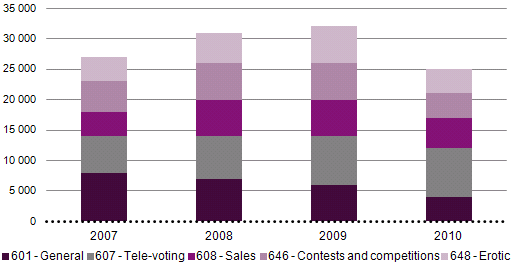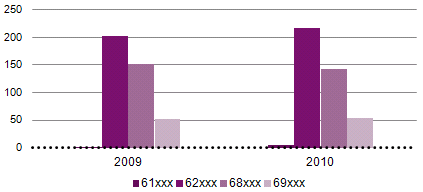Creation of a specific code (703) in the Plano Nacional de Numeração (National Numbering Plan) for electronic communications services on non-publicly available private networks and definition of the conditions to be applied
By determination of 19 November 2010, ICP-ANACOM approved the final decision on the creation of a specific "703" code in the PNN - Plano Nacional de Numeração (National Numbering Plan) for the provision of electronic communications services over non-publicly available private networks. Conditions were also established to govern the allocation and use of numbers associated with these services.
This decision was based on a request made by REFER TELECOM, which expressed a need for NNP numbering resources for the operation of its GSM-R network. In this sense, the company requested a mobile network code (MNC, pursuant to ITU-T recommendation E.212) and a national code (NDC, pursuant to ITU-T recommendation E.164).
In analyzing the request the following premises were considered:
- by determination of 6 August 2008, ICP-ANACOM authorized REFER TELECOM to operate the GSM-R system in the 876-880 MHz and 921-925 MHz frequency bands under the general authorization regime, according to the provisions of the LCE; operation of this system was made subject to the conditions deemed applicable (article 27 of the LCE), including the technical conditions set out in Decision ECC/DEC(02)05;
- the NTFA was amended, following the same determination, with respect to non-publicly available networks and electronic communications services, assigning and reserving the above frequency bands to the GSM-R system;
- the use of numbers depends on the allocation of rights of use of numbers by ICP-ANACOM, which allocation must be made according to procedures which are open, transparent and non discriminatory.
As a result of its analysis, ICP-ANACOM deemed that REFER's request could not be satisfied entirely using numbering ranges already constituted in the PNN, whereby it was necessary to define and designate a new service code for this purpose.
As such, ICP-ANACOM saw fit to submit the draft determination on the creation of a new code in the NNP to the general consultation procedure laid down in said article 8, and also to the prior hearing of the company under the CPA - Código de Procedimento Administrativo (Administrative Proceeding Code), after which the determination was approved.
Allocation of rights of use of numbers for electronic communications services
The following tables contain data on trends in the allocation of rights of use of numbers, including the volume of numbers resulting from allocations made during 2010, and the volume of recovered numbers.
|
Year |
Allocated and/or Reserved (A) or Recovered (R) |
Geographic numbers |
|||
| Lisbon Geographic area |
Porto Geographic area |
Other geographical areas |
Totals |
||
|
2007 |
A |
110,000 |
50,000 |
420,000 |
580,00 |
|
R |
10,000 |
0 |
0 |
10,000 |
|
|
2008 |
A |
190,000 |
70,000 |
1,040,000 |
1,300,000 |
|
R |
10,000 |
10,000 |
590,000 |
610,000 |
|
|
2009 |
A |
180,000 |
60,000 |
30,000 |
270,000 |
|
R |
0 |
0 |
490,000 |
490,000 |
|
|
2010 |
A |
280,000 |
160,000 |
170,000 |
610,000 |
|
R |
0 |
0 |
0 |
0 |
|
Source: ICP-ANACOM.
| Year | Allocated and/or Reserved (A) or Recovered (R) |
Nomadic VoIP Services |
Short numbers |
Translation and voice mail services |
Data Services (ISP) |
MTS | Totals |
|
2007 |
A |
180,000 |
9 |
120,000 |
0 |
1,400,000 |
1,700,009 |
|
R |
0 |
4 |
0 |
400 |
0 |
404 |
|
|
2008 |
A |
290,000 |
5 |
164,503 |
300 |
2,600,000 |
3,054,808 |
|
R |
50,000 |
8 |
140,000 |
400 |
350,000 |
540,408 |
|
|
2009 |
A |
70,000 |
2 |
0 |
0 |
1,500,000 |
1,570,002 |
|
R |
120,000 |
6 |
160,000 |
0 |
0 |
280,006 |
|
|
2010 |
A |
100,000 |
0 |
21,100 |
0 |
0 |
121,100 |
|
R |
0 |
2 |
10,000 |
0 |
0 |
10,002 |
Source: ICP-ANACOM.
The evolution reported since 2007 in the accumulated values of allocated numbers assigned at national level is presented below; in 2010 the growth of non-geographic numbers continued, although with a reduction in demand over the previous year, and an increase in geographic numbers, reversing the decline reported in 2009.
|
Year |
Geographic numbers |
Non-geographic numbers |
|
2007 |
6,560,000 |
3,959,655 |
|
2008 |
7,250,000 |
6,474,055 |
|
2009 |
7,030,000 |
7,764,051 |
|
2010 |
7,640,000 |
7,875,149 |
Source: ICP-ANACOM.
Graph 38 - Accumulated value of numbers allocated nationally

Source: ICP-ANACOM.
Allocation of numbers to audiotext and message-based valued added services
The following tables show data on the evolution in the allocation of rights of use of numbers to Audiotext companies, where much higher volume is reported in the return of numbers than in their allocation, reflecting a significant decrease in this activity in 2010.
| Year | Allocated and/or Reserved (A) or Recovered (R) |
Numbers for audiotext services 1 |
|||||
| General (601) |
Tele-voting |
Sales |
Contests and |
Erotic |
Totals |
||
|
2007 |
A |
4,000 |
2,000 |
2,000 |
1,000 |
1,000 |
10.000 |
|
R |
1,000 |
2,000 |
1,000 |
1,000 |
0 |
5,000 |
|
|
2008 |
A |
2,000 |
1,000 |
2,000 |
1,000 |
1,000 |
7,000 |
|
R |
3,000 |
0 |
0 |
0 |
0 |
3,000 |
|
|
2009 |
A |
0 |
1,000 |
0 |
0 |
1,000 |
2,000 |
|
R |
1,000 |
0 |
0 |
0 |
0 |
1,000 |
|
|
2010 |
A |
0 |
3,000 |
0 |
0 |
0 |
3,000 |
|
R |
2,000 |
3,000 |
1,000 |
2,000 |
2,000 |
10,000 |
|
Source: ICP-ANACOM.
|
Year |
Audiotext |
Totals |
||||
| General (601) |
Tele-voting (607) |
Sales |
Contests and competitions (646) |
Erotic (648) |
||
|
2007 |
8,000 |
6,000 |
4,000 |
5,000 |
4,000 |
27,000 |
|
2008 |
7,000 |
7,000 |
6,000 |
6,000 |
5,000 |
31,000 |
|
2009 |
6,000 |
8,000 |
6,000 |
6,000 |
6,000 |
32,000 |
|
2010 |
4,000 |
8,000 |
5,000 |
4,000 |
4,000 |
25,000 |
Source: ICP-ANACOM.
Graph 39 - Accumulated value of audiotext numbers allocated nationally

Source: ICP-ANACOM.
In 2009, with the publication of Decree-Law no. 63/2009 of 10 March on message-based valued added services, allocation was begun of rights of use of numbers with the codes established by ICP-ANACOM for this activity.
During 2010 the allocation of rights of use of these same types of numbers continued. Meanwhile, there have been some returns and some procedures taking place for the transmission of rights of use of numbers between companies.
As shown below, there was an increase of close to 3 percent reported in numbers allocated to these services in 2010.
| Year | Allocated and/or Reserved (A) or Recovered (R) |
Numbers for message-based valued added services |
||||
| Raising donations subject to different tax regime (61xxx) | Sending of more than one message or sending messages on a periodic or continuous basis, with added price per message (62xxx) | Not covered by the 61, 62 and 69 codes (68xxx) | Declared as having erotic or sexual content (69xxx) |
Totals |
||
|
2009 |
A |
1 |
202 |
151 |
51 |
405 |
|
R |
0 |
0 |
0 |
0 |
0 |
|
|
2010 |
A |
3 |
14 |
2 |
4 |
23 |
|
R |
0 |
0 |
11 |
1 |
12 |
|
Source: ICP-ANACOM.
| Year |
Numbers for message-based valued added services |
||||
| Raising donations subject to different tax regime (61xxx) | Sending of more than one message or sending messages on a periodic or continuous basis, with added price per message (62xxx) | Not covered by the 61, 62 and 69 codes (68xxx) | Declared as having erotic or sexual content (69xxx) |
Totals |
|
|
2009 |
1 |
202 |
151 |
51 |
405 |
|
2010 |
4 |
216 |
142 |
54 |
416 |
Source: ICP-ANACOM.
Graph 40 - Cumulative value of numbers for message-based
valued added services allocated at national level

Source: ICP-ANACOM.
Electronic Numbering (ENUM)
Following the workshop on "ENUM: What's the Future?" promoted and organized by ICP-ANACOM in 2009 and hosting presentations from national and international manufacturers, operators, sectorial regulators and DNS/ENUM registries, leading to broad debate, ICP-ANACOM considered it appropriate to deploy a pilot project on User-ENUM in Portugal, in the "1.5.3.e164.arpa" domain.
As such, and following up on its 2007 determination on ENUM, by determination adopted in early 2011, ICP-ANACOM appointed FCCN - Fundação para a Computação Científica Nacional (Foundation for National Scientific Computing) as ENUM Tier 1 Registry for managing this domain in the context of the pilot and approved the terms of a protocol to be concluded with FCCN providing for mutual cooperation in the deployment of the pilot.
Implementation of the ERG Common Position on VoIP
By determination of 30 July 2010, ICP-ANACOM approved the launch of a public consultation on the implementation of the common position of the European Regulators Group (ERG) on Voice over Internet Protocol (VoIP) and on the conditions governing use of geographic, nomadic and mobile numbers.
The main purpose of this consultation was to review the measures defined by ICP-ANACOM in its determination of 23 February 2006, following the public consultation on the "Regulatory approach to voice services over Internet Protocol technology (IP) (VoIP)", to adapt them and develop a harmonized regulatory framework for Europe on VoIP, in accordance with this common position.
This issue remains under review, pending final decision in 2011, to ensure a proper balance between flexible solutions for the use of geographic and mobile numbers and the reliability of the information that they provide about the location of users when they originate calls to emergency services - 112.
1 The numbers are allocated in blocks of 1,000.




